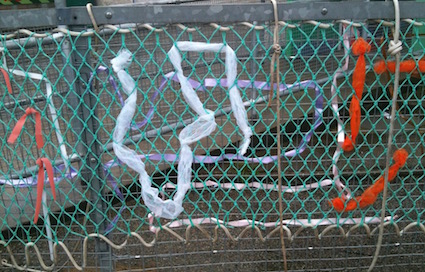
Weaving is an art form which lends itself remarkably well to an outdoor context. The opportunity to weave using natural materials or artificial materials on a bigger scale to indoors is exciting. There is freedom and space to behold! Big impromptu weaving moments are usually group affairs where children end up working together in the knowledge that something special is happening.
The photo above is many years old but remains one of my favourite. The nursery at South Park Primary in Fraserburgh had this weaving net in place for a long time. If you look carefully there are ropes attached so that children could weave these as and when they wished. Additional material was provided in different forms as a prompt.
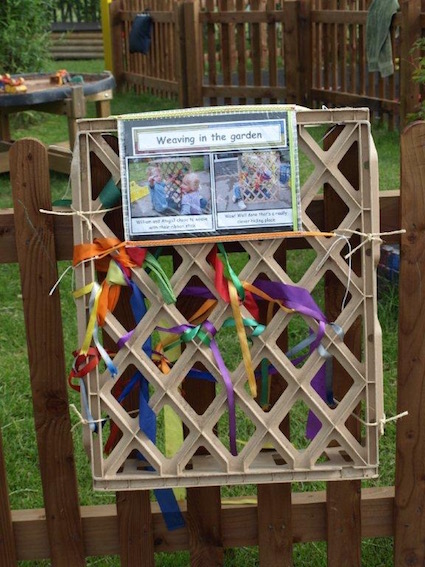
Bread crate weaving is another robust approach. At Alfreton Nursery, the colourful weaving happened spontaneously. A couple of children decided to hide the ribbon sticks and the above photo shows the colourful result.
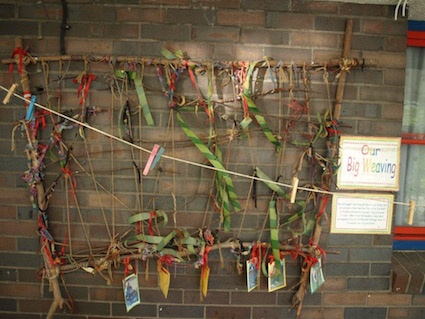
Alfreton Nursery children clearly seem to enjoy weaving. I’m a fan of natural frames like this with the twine because the children’s efforts are clearly displayed and it’s easy to see the children’s input. Also as you can see, it’s all about the process and not the product. Weaving in the early years will often be patchy and ad hoc. Children need to be able to come and go from a frame rather than be expected to participate.
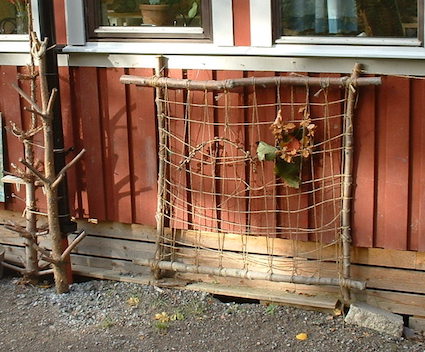
In the above photo, the frame is natural, but look at the twine compared to the Alfreton photo. In this photo, there is a warp and weft of twine. By making minor changes like this, the weaving experience for children will change. Suddenly the children will be able to weave vertically as well as horizontally. Below shows another weaving frame at the same Swedish outdoor nursery.
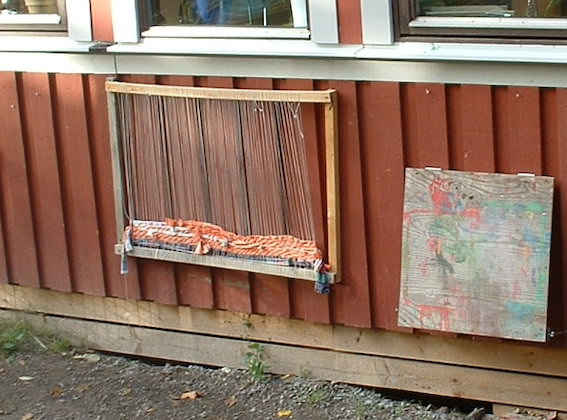
Another option is to use netting of different sorts to create the base for weaving experiments. Below snow mesh has been used which can be a good way to re-use small pieces.

Here’s another weaving frame which is sensible for outdoor use – look at the use of thin rope – a bit like skipping rope- as part of the frame. This will make it easier for little hands to learn how to weave. The stand beside it offers a range of weaving materials.
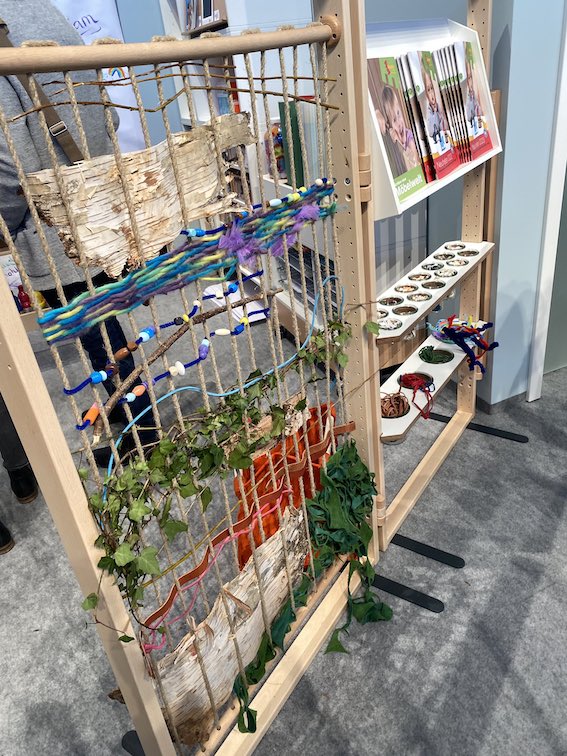
Next there is the decision about what to use as a frame or place for weaving. Creating a bespoke weaving frame as illustrated above is one possibility. Yet others exist. An example of re-purposing can be seen in this old chair frame. Often the challenge is creating the frame so items that lend themselves to being threaded up can save time, money and resources!
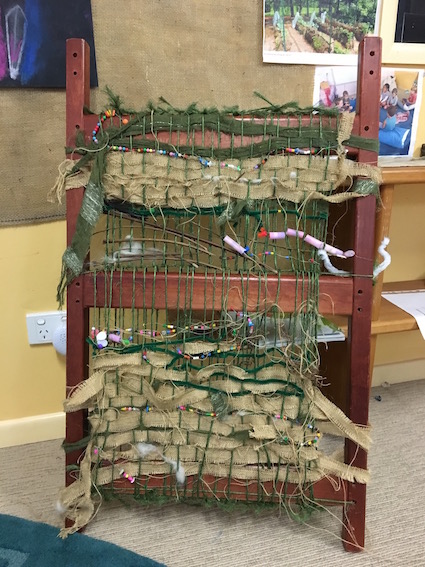
However in the photo below, it is clear that children have made the decision that the dividing frame needs a bit of colour.

Sometimes weaving can happen on structures that need the texture. At Belgrave Heights Christian Pre-school, there are a couple of woven cubbies which were much loved and well-used by the children in their role play. The original frames are made from long bamboo poles.
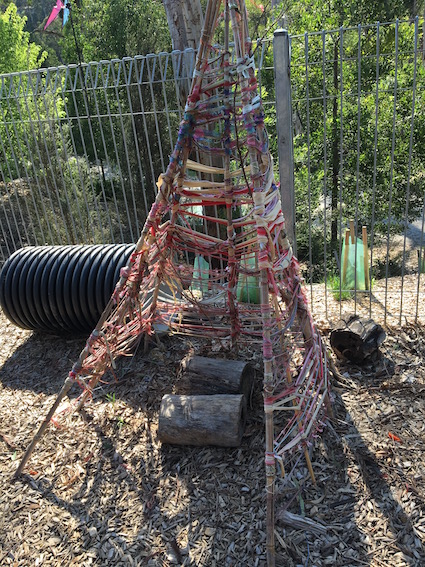
At Highway Farm, the out-of-school club and outdoor nursery children undertook similar work but used old rope, fishing nets and other long stringy outdoor materials. The detail is extraordinary.
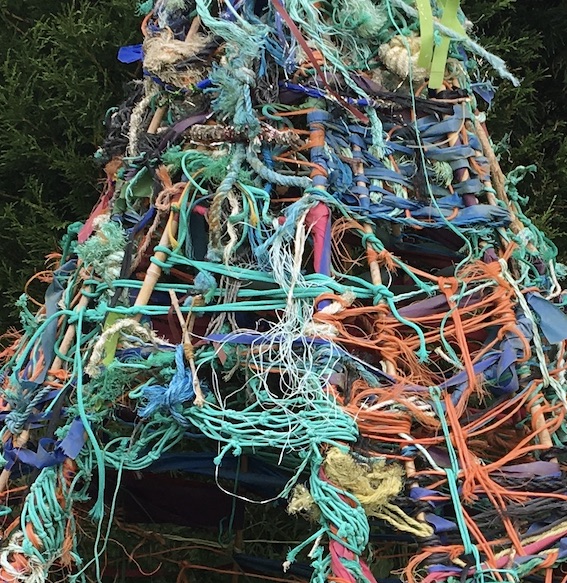
Fencing often demands a spot of weaving work. Whilst having a frame can provide a good boundary for such activities, children also love the opportunity to extend the experience far and wide:
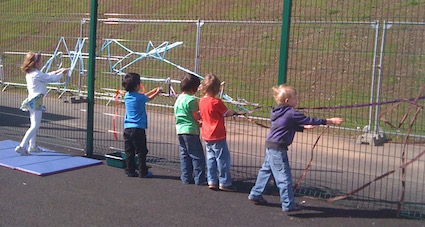
Many years ago, one popular “fad” was to weave plastic strips through fences. This can be a good way to repurpose bags which are already torn, provided the strips are secure and unlikely to be blown away as litter.

Another option is to explore weaving that may have taken place inside but can withstand being displayed outside. Many years ago at Inverallochy School, metal hangers were used as weaving frames. Older children also created mini-mats. These were hung attractively together outside:
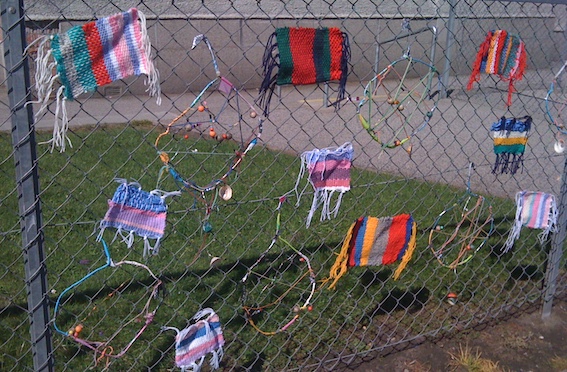
When considering weaving possibilities, there are also large-scale and less traditional perspectives. Firstly, the use of willow structures provides children of all ages with opportunities to participate in the weaving in of new shoots every winter. This practical job may appeal to some children who seek real world skills.
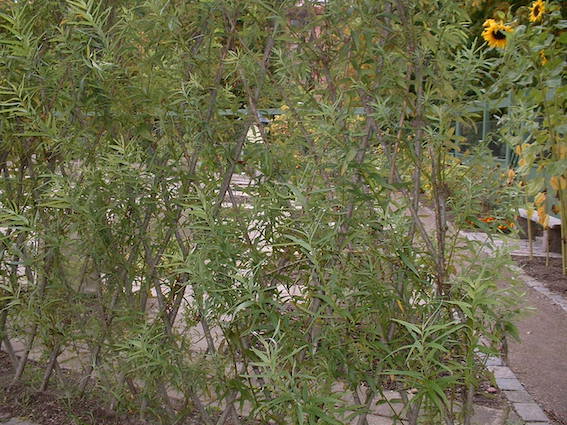
For children who seek whole body movements, never forget the joy of weaving oneself in, out and through rope structures. Ideal for those who know that they are Spider Man!
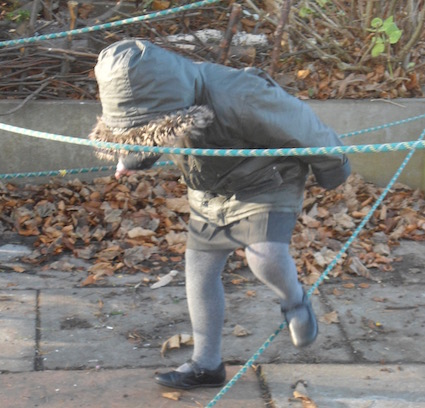
If children get into weaving themselves through rope structures, then link it to songs such as “Let the Little Butterfly Through the Gate” or “In and Out the Dusty Bluebells.” and show children the fun of songs which involve physically weaving in and out of a circle of children. When children have whole experiences such as moving through a web, this can also provide a link to the concept of weaving. Below is a wonderful example of a net structure at Spirit of Play School in Western Australia which the primary-aged children enjoyed using.

Another consideration is what to weave. Really any space can be threaded up! Weaving a forked branch is a good spur-of-the-moment “grab ‘n’ go” approach to weaving. Leaving such creations in the ground can be useful. Take a photo each day and capture the decaying process. Often children do not think about what happens after a creative act has occurred so to witness this happen is a useful discussion point.
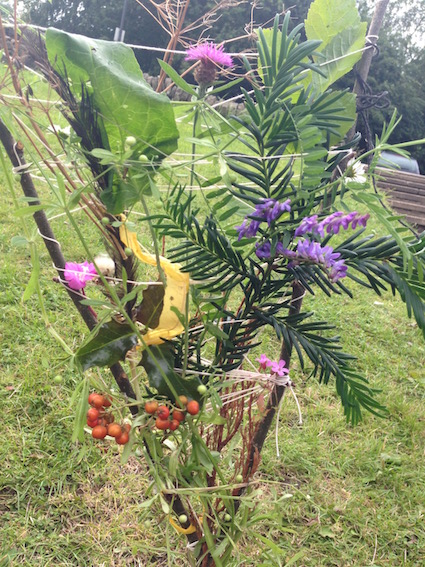
Items can also be woven into structures to benefit wildlife. In the photo below, the children decided to weave wool into the fence so that birds could help themselves to it to line their nests.

Next, there is a lot of co-ordination required to develop the skill of weaving. So thinking about the spacing needed can be helpful as well as a choice of materials. At the Ananda Marga River Pre-school, the approach is very much down to the children’s motivation. There’s a table where wool is available and long twigs. It’s up to the children to decide if they want to create any structures and what these will be.
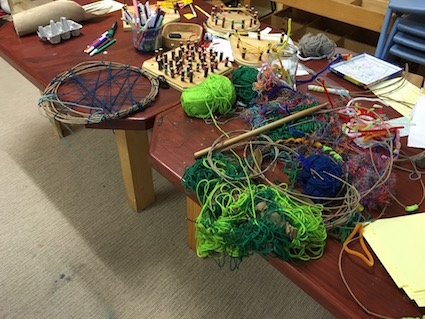
Anything long can be used for weaving including: string, wool, rope, cord, old bandages, long grass and plant stems, bendy sticks, fleece, old plastic torn into strips, foil, cellophane, strips of old material, wire, pipe cleaners and so on. It’s a great way to use up resources that have been lost for years in cupboards. The variety of textures, the pliability of the materials and details of each piece are all talking points.
When thinking about the learning which happens through weaving, there’s lots to consider. Firstly there is the language of position and vocabulary such as “up” and “down” or “in” and “out”. It’s an opportunity to talk about “longer” and “shorter” and other length related vocabulary. When looking at weaving that others have done or materials which have been clearly woven, then introduce the words ‘warp’ and ‘weft’ and explain that ‘warp’ goes from top to bottom and ‘weft’ weaves in and out of it.
All-in-all, it’s a good thing to consider how you would weave such opportunities into your outdoor provision 🙂 I’ve also blogged about different sorts of weaving such as:
- Making outdoor fleece mats using peg looms
- Using a weaving technique to create tripod stands
- Masking tape investigations here and here.
Thanks to the pre-schools mentioned for their inspirational work – the chair and the lovely divider in two of the photos are also from the Ananda Marga River Preschool in Queensland, Australia.
This blog post was originally published in September 2016.




















As I look at the many woven strands it reminds me of the many dimensions of learning; diverse, relational and messy!